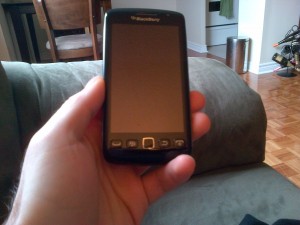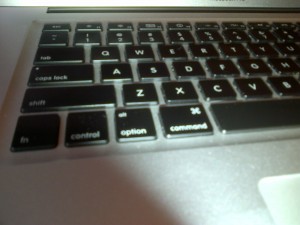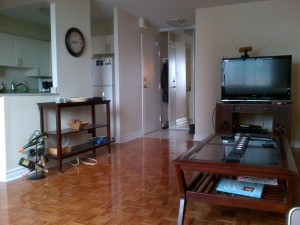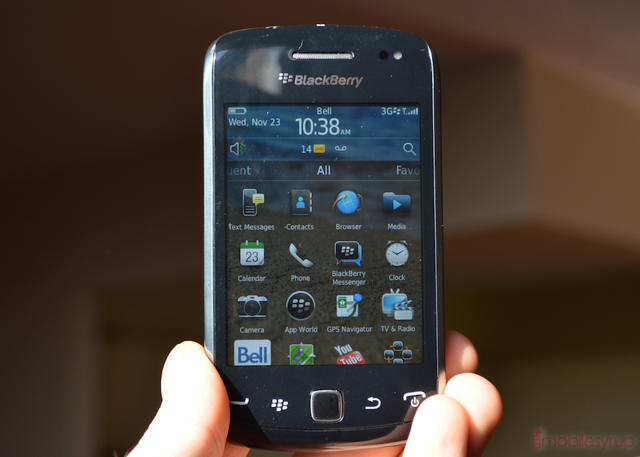
Nostalgia is a funny thing. Though last year I left my BlackBerry behind for the shinier, app-centric shores of iOS and Android, I still recall my experiences fondly. There are times I miss the great keyboard, push email and how easy it is to compose lengthy soliloquies like it’s nothing at all. I retain a closeted affection for BBM and the friendships I clung to so dearly through PIN. But mostly I miss that flashing red light, hounding me to check my phone, check my phone, check my phone.
Since the arrival of BlackBerry 7, RIM has emphasized that they too can play the smartphone game in 2011. And in many ways they have succeeded, at least in retaining their current user base; I see a lot of Bold 9900’s when I’m out in public. And while others, like me, have left for greener pastures, we’re always willing to come back for a visit.
The Curve 9380 is the first all-touch Curve device, and is intended to bridge that small gap between entry-level and high-end consumer devices. To its credit the Curve feels great in the hand: it is well-constructed, and employs many of the same technologies, like NFC, that are available in RIM’s most expensive models. It also aims to convince users that there doesn’t need to be a hardware keyboard for it to be called a BlackBerry.
Will the masses listen, and is the Curve 9380 worth buying? Read on to find out.
Specs:
– 800Mhz Marvell processor
– 3.2″ 360×480 capacitive touch display
– 512MB RAM / 512MB ROM
– 5MP EDoF camera w/ LED flash
– VGA video capture
– WiFi (b/g/n), Bluetooth 2.1 w/ A2DP, A-GPS, NFC
– 1230mAh battery
– 109 x 60 x 11.2 mm
– 98g

The Phone
The Curve 9380 hues closely to the keyboard-adorned 9360 in its design, which means it’s very light, thin and fluid. At 11.2mm thick, the body barely registers in the hand; at 98g, it disappears in a pocket or bag. RIM has honed down the right-side convenience and volume buttons to such an extent they now flit out like little nubs, barely perceptible unless your fingers brush upon them. This is by no means a negative trait: the phone’s design is about as simple as it gets.
While the 9380 forgoes the weighty aluminum battery cover of its big brother, the Torch 9860, in other places it is constructed with premium plastic and a high-quality glass. The four buttons below the screen are actually housed within the glass which lends a sense of continuity to the form. It’s clear RIM wanted very little to distract from the main event: the 3.2″ screen. At 360×480 its resolution is quite low on paper but I didn’t find myself wanting for smaller text or sharper images. But for the browser, which would have benefited from more zoom, the Curve’s size relative to its resolution felt well matched.
As with all recent BlackBerry devices there is a standard-issue trackpad for text selection and other “legacy” functions. That the BlackBerry ecosystem still requires four buttons and a trackpad reasserts the issue that the OS needs doing away with — text selection and secondary context functions are finicky and unreliable via touchscreen alone — but neither are they intrusive. Around the left side, centred, is a microUSB charging port, while on top of the device is a headphone jack. The lock button has been built into the top, too, again contiguous with the front glass. Instead of being a separate button like on most phones, RIM has integrated the function without disturbing the form: more OEMs would benefit from such design edification.
The battery cover is made of plastic that, while relatively secure while attached, seems immediately like it’s going to break into a thousand pieces when removed. The company has done a great job unifying its battery line, though: both the new Bold 9790 and the Curve 9380 use the same JM1 battery found in the Bold 9900. Whether this translates into sufficient longevity we’ll talk about later.
I must say that one thing RIM is doing quite well is the continuing honing and simplifying of their designs. There isn’t another mobile company in the world that has honed a single design element to such an extent as to be instantly recognizable and yet modern and thoughtful. To compare the Curve 9380 to, say, the original Curve 8100 would be a lesson in refinement and careful, mindful planning.
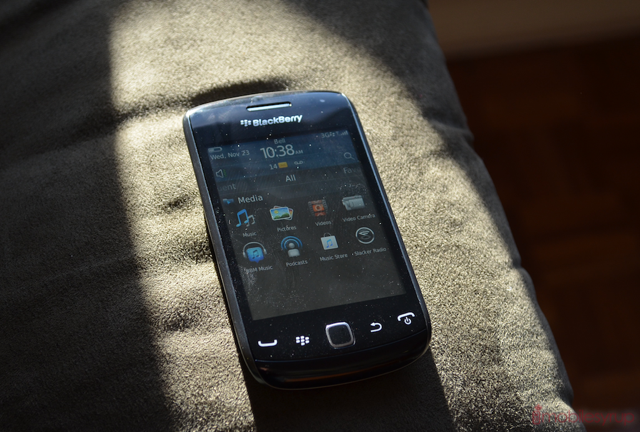
The Display & Keyboard
While sufficient resolution for the size, the quality of the LCD is another matter. Low-quality, with noticeable gradient banding and a distracting, visible digitizer layer, I’ve seen better from RIM. Compared to the high-density display on the Bold 9900 or the fantastic, crisp LCD in the Torch 9860, this is clearly the Curve’s weakest trait.
Couple that with a stubborn digitizer that wouldn’t always register our key taps, we were loathe to try to type on this Curve. My frustration abates, however, when I keep in mind this device is meant for entry-level smartphone users, many of whom will have never used a touchscreen before. Comparing the quality to, say, that of entry level Android or Nokia device the Curve’s display is unequivocally better, even if $100 more expensive.
Colour reproduction is a strength, with solid contrast and accurate whites. Text, while large, is crisp and readable, which is a good thing because as a BlackBerry user you’ll undoubtedly doing a lot of reading and scrolling. Viewing angles are great, as is maximum brightness.
My main concern with the display is its responsiveness. Occasionally I would be scrolling down the BB7 home screen only to have a touch register as a press when it should have registered as a fluid scrolling motion. Similarly, when typing, the cursor would move randomly as if being roused by a phantom. Rarely could I get through an entire sentence without the cursor finding its way magically back to the beginning of the text input box. I could type quickly or slowly, it did not matter; the keyboard would register my presses incorrectly more often than not.
This is a problem for a BlackBerry device. As I’d come to learn with the mostly-excellent Torch 9860, RIM’s virtual keyboard is a different beast altogether than the one I was used to on iOS and Android. Key placement aside, it just feels strange, as if you need to be more deliberate, more evenly-paced. With the Torch, however, once I found a rhythm I was fine; the Curve, in portrait or landscape, full QWERTY or reduced, I continued to have recognition issues.
Granted, I did have a pre-production model, and RIM emphasized that hardware was not yet final. Let’s hope that this batch I got mine from was not fit for public consumption.
Camera
The 5MP camera on the Curve 9380 is decidedly better than that of the previous Curve generation. Anyone upgrading from the 8520 or 9300 will be delighted at being able to make out actual details in images. Such things I take for granted, certainly, but it always astounds me the number of friends I have happily snapping portrait and lanscape shots on their entry-level BlackBerry devices.
This isn’t to say the Curve 9380’s camera is good by any means, just significantly improved. Its EDoF nature makes actual focusing impossible; the idea is that the camera, past a certain point, is always in focus. As a result, taking photos is much faster because there is no focusing motor getting in the way of a quick photo. The upshot is that macro photography is impossible: shots closer than, say, five inches, are fuzzy and out of focus.
The flash does an excellent job in close proximity, wisely under- instead of over-compensating. It suffices for nearby portrait photos or in a dimly-lit room. There is a good amount of detail in each 5MP photo, though a fair amount of grain to go along with it.
Video is taken at a maximum of 640×480, likely due to the limitations of the 800Mhz processor than the optical sensor. While chugging along at a smooth 30fps, the quality is poor and appropriate for base YouTube fare or sending an email of your cat around the office.
In its default state, the phone comes with space for fewer than 30 photos and no video. It is incumbent on you, or your carrier, to provide a modestly-sized microSD card so that you may enjoy your music, video and photos to their fullest extent. Because we received our demo unit straight from RIM itself, I can’t comment on individual carrier phone bundles but it is more than likely the Curve 9380 will come with a 2GB card.
Software & Performance
This is BlackBerry 7. An improved, touch-friendly, Liquid Graphics-filled operating system, with most of the same elements that made BB OS either indelibly attractive or untenable repulsive to the masses over the past few years. For BlackBerry Lovers, the new experience is a necessary and functional refresh; to BlackBerry Haters, it’s too little, too late. Leaving behind the love it/hate it debate, however, how has BlackBerry 7 iterated since its release?
Quite well, to be honest. In spite of this particular model’s touch issues, BlackBerry 7 is responsive and attractive, with a modular framework that allows you to see exactly what you want to, and hide what you don’t. Since the first wave of BB7 devices, RIM has released numerous bug fix and performance improving updates to its first-party apps: BBM, BlackBerry Protect, News, Traffic, Podcasts, as well as BBM Music, its newest foray into social music. There really is a lot to like here, and out of the box it covers most of the “primary needs” of a mobile OS: phone, email, SMS, news, music, media.
If you’ve ever used BlackBerry OS, things are going to be pretty similar and much, much faster. If you are upgrading from a previous Curve, say an 8520 or 9300, either the Curve 9360 or this phone will seem like a huge upgrade. Both in terms of speed and fluidity, RIM has done an excellent job with overall performance. Rarely will you see that dreaded BlackBerry “spinning clock” and we noticed few, if any, app crashes. Since this is the last version of BlackBerry OS — next year RIM is moving over its entire fleet of phones to the BBX platform — it’s about time the Java-based framework reached a modicum of maturity. As I touched on in our Curve 9360 review, BlackBerry 7 is not a cure-all, rectifying all problems from previous versions. Rather it completes the shaky cycle of iterative software and hardware improvements, and we can happily say the BB7 line didn’t let us down as it neared its sunset.
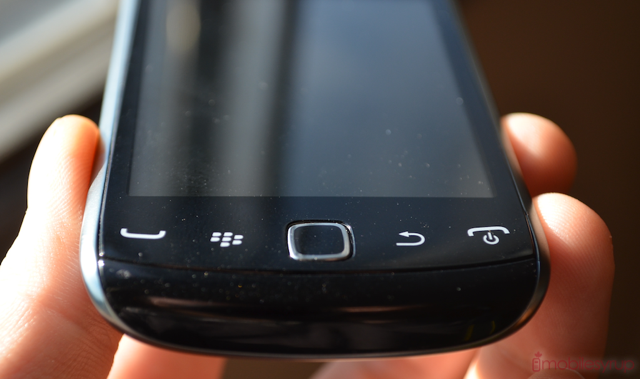
In many ways the interface is still touch unfriendly. All those keyboard shortcuts — “T” to the top, “B” to the bottom, “C” to compose, etc. — are missing here. You will do a lot thumb flicking when scrolling long web pages or through email threads. Indeed, the entire text-and-selection procedure is more frustrating than it should be. Companies like Apple and HTC have implemented them rather well, but RIM seems to hold onto the “peck-and-hope” technique. Sure, there is a blue line that appears underneath next, but getting it to go where you want and copy what you want is entirely unintuitive.
Despite the niggling issues with text input and selection, the email, browsing and BBM experience remain as robust as ever, and that’s really why you’re buying a BlackBerry, right? With the unified BlackBerry ID you can transfer BIS data including email accounts (and therefore synchronized Gmail contacts and calendars) from device to device without issue. With remote restore you can retain your BBM list. With BlackBerry Protect you can backup all that data to the cloud, and locate your phone in case it is lost or stolen.
Browsing is also much, much better on the all-touch Curve 9380. Unlike the 9360 with its 2.2″ screen and lack of touch, even BlackBerry 7’s Liquid Graphics couldn’t save it from a disastrous browsing fate. Thankfully, the Curve 9380 has the chops to render web pages accurately — even high-bandwidth HTML5-heavy ones — and relatively quickly. The 800Mhz processor does, at times, show a modicum of checkerboarding, but nothing like in previous generations.
One of the biggest advantages to having a larger screen is when looking at photos and watching video clips. While it’s not recommended to catch up on your favourite movies on such a small screen, the experience is far better than a traditional QWERTY BlackBerry device. Flipping through pictures in the Gallery or reading through long emails is less exhausting with a bigger screen.
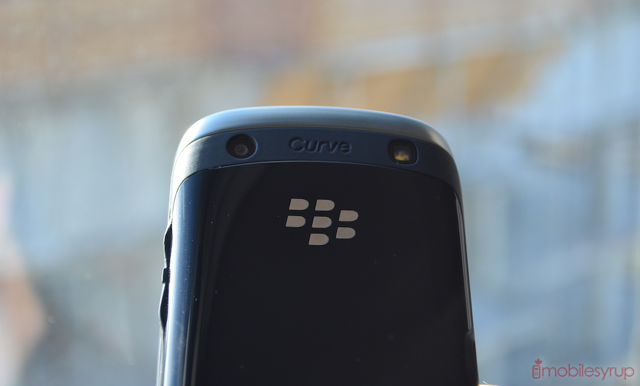
Call Quality & NFC
We used our trust Bell SIM to power the Curve 9380’s 3G network connection — which maxes out at 7.2Mbps — and call quality was, as expected, excellent. Though the network is theoretically slower than RIM’s flagship devices, because data is so highly compressed through BIS, we hardly noticed the difference.
Maximum call volume also exceeded our expectations, as did the tiny speaker on the back of the device. While aimed at consumers, the Curve is a great business device: making phone calls has always been a strength of BlackBerry.
RIM’s continued inclusion of NFC in their entry-level devices is meant to solidify its place in the mainstream. While use is limited at the moment, once BlackBerry 7.1 arrives, and with it BlackBerry Tags (which we showed off the other day) it will become really useful.
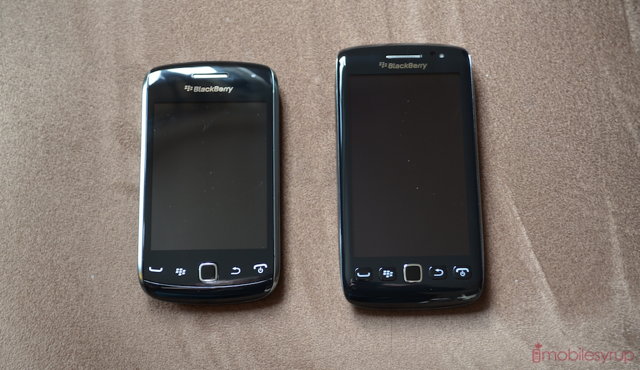
Battery Life
Because the 9380 uses the same battery as the Bold 9900, we tempered our expectations and as a result were pleasantly surprised. The 1230mAh battery is plenty to power the device through the day, and then some. We looped a video clip for 7 hours and 15 minutes before the battery finally gave out. In real-world usage, the Curve lasted us nearly 26 hours based on stats in the usage menu.
If you are looking to repeat the multiple-day battery life of non-touch BlackBerry devices, you’re out of luck, and you might as well get used to the new modus operandi. As RIM incorporates touchscreens into their phones, battery life will continue to go down. And considering this generation may be the last of the non-touch BlackBerries, I’d get used to it.
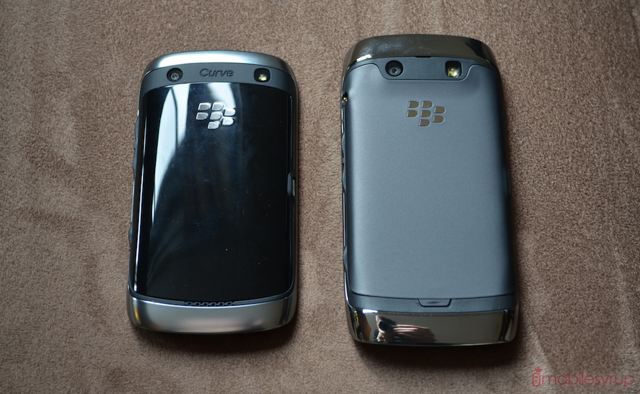
Final Thoughts
Considering Telus is launching the Curve 9380 for $49.99 on a 3-year term and $369.99 outright, which is presumably the same price the other carriers will launch at, RIM is positioning it as a high-tier entry-level device. We have no doubt it will quickly hit $0 on a 3-year term, but it’s hard to imagine the swaths of teens currently using keyboarded Curves primarily for BBM trading them in for an all-touch BlackBerry, just for a little extra screen real estate. As we’ve learned with the tepid response of the Torch 9860, selling an all-touch BlackBerry is a difficult proposition.
Insofar as RIM has built an excellent device, the Curve 9380 does everything right: it’s premium-feeling, fast and stable, with a nice big screen and sleek design. But it’s the little things that suffer: the keyboard is awkward and unreliable, and the resolution is low. The camera is a big step up from previous Curves but doesn’t compete with the industry-standard results we see in the iPhone 4 or Galaxy Nexus.
In short, you already know if this is the phone for you, or for your daughter. If you can master the virtual keyboard, it’s a great device. If not, you’ll long for that Curve 8100. I know I’m still nostalgic.
Rating: 6.5/10
Pros:
– Excellent design, well-built
– Good battery life for a BlackBerry 7 device
– Solid screen quality
– Good performance for the price
– BlackBerry 7 is fast and stable (compared to previous versions)
– Camera takes decent shots
– Great call quality
– Good sound from the speaker
– NFC a nice inclusion
Cons:
– Video quality subpar
– Low-resolution screen makes for a lot of scrolling
– Keyboard is awkward and unreliable
– High outright price
– Disappointing battery life compared to previous Curves
MobileSyrup may earn a commission from purchases made via our links, which helps fund the journalism we provide free on our website. These links do not influence our editorial content. Support us here.


